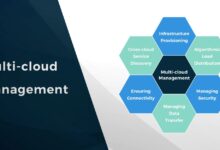Hybrid Cloud Solutions: 7 Powerful Benefits You Can’t Ignore
Imagine having the best of both worlds—scalability of the public cloud and control of your private infrastructure. That’s exactly what hybrid cloud solutions offer. In today’s fast-evolving digital landscape, businesses are turning to hybrid models for agility, security, and cost-efficiency.
What Are Hybrid Cloud Solutions?

Hybrid cloud solutions combine public cloud services, private cloud environments, and on-premises infrastructure, allowing data and applications to be shared across them seamlessly. This integration enables organizations to maintain control over critical systems while leveraging the scalability and cost benefits of public cloud providers like AWS, Microsoft Azure, or Google Cloud.
Defining the Hybrid Cloud Model
The hybrid cloud model is not just a mix of clouds—it’s a strategic integration. It allows workloads to move between private and public clouds based on computing needs, cost, compliance, or performance requirements. According to IBM, a true hybrid cloud must have consistent management, orchestration, and portability across environments.
- Public cloud: Services delivered over the internet by third-party providers.
- Private cloud: Dedicated infrastructure used exclusively by one organization.
- On-premises: Physical servers and data centers managed internally.
This blend allows companies to avoid vendor lock-in, optimize performance, and meet regulatory demands without sacrificing innovation.
How Hybrid Cloud Differs From Multi-Cloud
While often confused, hybrid cloud and multi-cloud are not the same. A multi-cloud strategy uses multiple public cloud services (e.g., AWS + Google Cloud), but may not include a private cloud. In contrast, hybrid cloud specifically integrates private and public environments.
“Hybrid cloud is about integration; multi-cloud is about diversity.” — Gartner
The key differentiator is workload portability and unified management. Hybrid solutions often use orchestration tools like Kubernetes or Red Hat OpenShift to manage containerized applications across environments.
Core Components of Hybrid Cloud Architecture
A robust hybrid cloud setup includes several essential components:
- Cloud Management Platform (CMP): Tools that provide visibility and control across cloud environments (e.g., VMware vRealize, Microsoft Azure Arc).
- Networking: Secure, high-speed connections such as VPNs or dedicated links (e.g., AWS Direct Connect, Azure ExpressRoute).
- Security & Identity Management: Unified policies for access control, encryption, and threat detection across all environments.
- Automation & Orchestration: Enables seamless deployment and scaling of applications across clouds.
These components ensure that hybrid cloud solutions are not just technically feasible but operationally efficient.
Why Businesses Are Adopting Hybrid Cloud Solutions
The shift toward hybrid cloud solutions isn’t just a trend—it’s a strategic response to real business challenges. From digital transformation to regulatory compliance, organizations are finding that a one-size-fits-all cloud approach no longer works.
Flexibility and Scalability
One of the biggest advantages of hybrid cloud solutions is the ability to scale dynamically. During peak demand—like holiday sales or product launches—companies can burst into the public cloud to handle increased traffic without over-provisioning private infrastructure.
For example, retail giants like Walmart use hybrid models to manage seasonal spikes. Their core inventory and customer data remain secure on-premises, while front-end web services scale in the public cloud during Black Friday events.
Cost Optimization
Hybrid cloud solutions enable smarter cost management. Businesses can run stable, predictable workloads on private infrastructure (where costs are fixed) and shift variable or temporary workloads to the public cloud (pay-as-you-go).
According to a McKinsey report, companies using hybrid strategies can reduce IT spending by up to 30% compared to full public cloud migration.
- Avoid over-provisioning of on-prem servers.
- Leverage public cloud for short-term projects or testing.
- Optimize licensing and resource utilization.
Regulatory Compliance and Data Sovereignty
In industries like finance, healthcare, and government, data residency laws require certain information to stay within national borders or private networks. Hybrid cloud solutions allow these organizations to keep sensitive data on-premises or in a private cloud while still using public cloud services for less sensitive operations.
For instance, the EU’s GDPR mandates strict controls over personal data. A hybrid model lets European banks process transactions locally while using public cloud AI tools for fraud detection, provided data anonymization and secure APIs are in place.
Key Benefits of Hybrid Cloud Solutions
Organizations that implement hybrid cloud solutions gain a competitive edge through improved performance, resilience, and innovation. Let’s explore the seven most powerful benefits in detail.
1. Enhanced Security and Control
With hybrid cloud solutions, businesses can apply granular security policies based on data sensitivity. Critical systems—like ERP or HR databases—can reside in a tightly controlled private environment, while customer-facing apps run in the public cloud.
Advanced security features such as zero-trust architecture, end-to-end encryption, and multi-factor authentication can be uniformly applied across both environments. Tools like Microsoft Azure Security Center or AWS Security Hub provide centralized monitoring and threat intelligence.
“Security is not a cloud problem—it’s a configuration problem. Hybrid models allow better control over configurations.” — NIST
2. Improved Disaster Recovery and Business Continuity
Hybrid cloud solutions significantly enhance disaster recovery (DR) capabilities. Instead of relying solely on physical backups, companies can replicate on-premises data to the public cloud in real time.
This approach reduces recovery time objectives (RTO) and recovery point objectives (RPO). For example, a hospital system can back up patient records to AWS while maintaining primary access through a private data center. If the local system fails, operations can quickly failover to the cloud.
- Automated backup and replication.
- Geographically distributed redundancy.
- Lower DR infrastructure costs.
3. Support for Legacy Systems and Digital Transformation
Many enterprises still rely on legacy applications that can’t be easily migrated to the public cloud. Hybrid cloud solutions allow these systems to coexist with modern, cloud-native applications.
For example, a manufacturing company might keep its decades-old inventory management system on-premises while building new IoT analytics platforms in the public cloud. APIs and middleware bridge the gap, enabling data flow without disruption.
This gradual transition supports digital transformation without the risks of a “big bang” migration.
Challenges of Implementing Hybrid Cloud Solutions
Despite their advantages, hybrid cloud solutions come with complexities. Organizations must navigate technical, operational, and cultural hurdles to succeed.
Integration Complexity
Connecting disparate systems—on-prem servers, private clouds, and multiple public cloud providers—requires robust integration. Without proper tools, this can lead to data silos, inconsistent performance, and management overhead.
Solutions include using API gateways, service meshes (like Istio), and cloud-agnostic platforms such as Kubernetes. These technologies standardize communication and deployment across environments.
Data Latency and Network Performance
Data moving between on-prem and cloud environments can suffer from latency, especially if the network connection is slow or unreliable. This impacts real-time applications like video processing or financial trading systems.
To mitigate this, businesses invest in high-speed dedicated connections (e.g., AWS Direct Connect) or edge computing nodes that process data closer to the source before sending it to the cloud.
Skills Gap and Workforce Training
Managing hybrid cloud solutions requires expertise in multiple domains: networking, security, cloud platforms, and automation. Many IT teams lack experience with public cloud tools or containerization.
Organizations must invest in training or partner with managed service providers. Certifications from AWS, Azure, or Google Cloud can help bridge the knowledge gap.
Hybrid Cloud Solutions and Digital Transformation
Digital transformation is no longer optional—it’s a survival imperative. Hybrid cloud solutions act as a catalyst, enabling organizations to innovate faster while maintaining stability.
Enabling Cloud-Native Development
Hybrid environments support modern development practices like DevOps, CI/CD pipelines, and microservices. Developers can build and test applications in the public cloud, then deploy them to private infrastructure for production.
For example, a fintech startup might use AWS for rapid prototyping and user testing, then move the final application to a secure private cloud for compliance reasons.
- Faster time-to-market for new features.
- Improved collaboration between development and operations teams.
- Consistent environments across dev, test, and production.
Supporting AI and Big Data Analytics
Hybrid cloud solutions are ideal for AI and big data workloads. Sensitive raw data can stay on-premises, while anonymized datasets are processed in the public cloud using powerful machine learning tools.
For instance, a telecom company can analyze customer behavior using Google Cloud’s AI platform while keeping personally identifiable information (PII) in a secure internal database.
This approach balances innovation with privacy and compliance.
Driving Innovation Without Disruption
One of the greatest strengths of hybrid cloud solutions is their ability to foster innovation without disrupting core operations. Businesses can experiment with new technologies—blockchain, IoT, AR/VR—in the public cloud while keeping mission-critical systems stable.
This sandboxing effect reduces risk and allows for controlled innovation.
Top Providers of Hybrid Cloud Solutions
Several technology leaders offer comprehensive hybrid cloud solutions, each with unique strengths. Choosing the right provider depends on your existing infrastructure, industry needs, and long-term strategy.
Microsoft Azure Stack and Azure Arc
Microsoft’s hybrid offerings are among the most mature. Azure Stack allows organizations to run Azure services on-premises, while Azure Arc extends management to any infrastructure—on-prem, edge, or multi-cloud.
This makes it ideal for enterprises already invested in Microsoft technologies like Windows Server, SQL Server, or Active Directory.
- Seamless integration with existing Microsoft ecosystems.
- Unified governance and security policies.
- Support for Kubernetes and containerized workloads.
Learn more at Microsoft Azure Hybrid Cloud.
Amazon Web Services (AWS) Outposts
AWS Outposts brings native AWS services, infrastructure, and APIs into on-premises data centers. It’s designed for workloads that require low latency or local data processing.
Industries like manufacturing, healthcare, and media use Outposts to run applications locally while integrating with the broader AWS ecosystem.
- Fully managed by AWS.
- Consistent APIs and tools across environments.
- Support for EC2, EBS, S3, and more on-premises.
Explore AWS Outposts at AWS Official Site.
Google Cloud Anthos
Google Cloud’s Anthos is a modern, open-architecture platform for managing applications across on-prem, Google Cloud, and other clouds. Built on Kubernetes and Istio, it emphasizes portability and automation.
Anthos is ideal for organizations committed to open-source technologies and containerization.
- No vendor lock-in.
- Centralized policy enforcement.
- Integrated monitoring and logging via Cloud Operations.
Visit Google Cloud Anthos for details.
Best Practices for Deploying Hybrid Cloud Solutions
Success with hybrid cloud solutions depends on more than just technology—it requires strategic planning, governance, and continuous optimization.
Start with a Clear Strategy and Use Cases
Before deploying, define clear objectives: Are you aiming to reduce costs? Improve disaster recovery? Support digital transformation? Identify specific workloads that benefit most from hybrid deployment.
For example:
- Migrate non-sensitive development environments to public cloud.
- Keep financial systems on-premises for compliance.
- Use public cloud for AI training, private cloud for inference.
Implement Unified Management and Monitoring
Use cloud management platforms (CMPs) to gain visibility across all environments. Tools like VMware vRealize, Red Hat CloudForms, or Turbonomic provide centralized dashboards for performance, cost, and security.
Monitoring should include:
- Resource utilization (CPU, memory, storage).
- Cost tracking per department or project.
- Security alerts and compliance checks.
Adopt Automation and Infrastructure as Code (IaC)
Manual configuration leads to errors and inconsistencies. Use IaC tools like Terraform, Ansible, or AWS CloudFormation to define and deploy infrastructure programmatically.
Automation ensures that environments are reproducible, secure, and compliant. For example, every time a developer spins up a test environment, the same security policies and network rules are applied automatically.
Prioritize Security and Compliance
Security must be baked into the hybrid cloud architecture from day one. Implement:
- Zero-trust network access (ZTNA).
- End-to-end encryption (in transit and at rest).
- Role-based access control (RBAC).
- Regular audits and vulnerability scanning.
Ensure compliance with standards like ISO 27001, SOC 2, HIPAA, or GDPR through automated policy enforcement.
Future Trends in Hybrid Cloud Solutions
The evolution of hybrid cloud solutions is accelerating, driven by advancements in AI, edge computing, and sustainability. Organizations that stay ahead of these trends will gain a significant advantage.
Rise of Edge-Hybrid Cloud Integration
As IoT devices and 5G networks proliferate, data is generated at the edge—factories, retail stores, vehicles. Hybrid cloud solutions are evolving to include edge computing nodes that process data locally before sending insights to the central cloud.
For example, an autonomous vehicle manufacturer might use edge servers in test facilities to analyze sensor data in real time, while storing aggregated results in a public cloud data lake.
AI-Driven Cloud Management
Artificial intelligence is being used to optimize hybrid cloud operations. AI-powered tools can predict traffic spikes, automatically scale resources, detect anomalies, and recommend cost-saving measures.
Google’s Cloud Operations suite and AWS’s DevOps Guru are early examples of AI-driven cloud management.
Sustainability and Green Cloud Computing
With growing focus on ESG (Environmental, Social, and Governance), hybrid cloud solutions are being optimized for energy efficiency. Companies can route workloads to data centers powered by renewable energy or use public cloud providers with strong carbon neutrality commitments.
Microsoft, for instance, aims to be carbon negative by 2030 and offers tools to measure the carbon footprint of Azure workloads.
What are hybrid cloud solutions?
Hybrid cloud solutions integrate public cloud services, private cloud infrastructure, and on-premises systems to create a flexible, scalable, and secure computing environment. They allow businesses to run workloads where they make the most sense—based on cost, performance, or compliance.
What are the main benefits of hybrid cloud solutions?
The key benefits include cost optimization, enhanced security, improved disaster recovery, support for legacy systems, and greater flexibility for digital transformation. Hybrid models also enable innovation through cloud-native development and AI without compromising control.
How do hybrid cloud solutions improve security?
By allowing sensitive data to remain in private or on-premises environments while leveraging public cloud for less critical operations, hybrid cloud solutions provide granular control over security policies. Unified identity management, encryption, and zero-trust models further enhance protection.
Which companies offer the best hybrid cloud solutions?
Top providers include Microsoft (Azure Stack, Azure Arc), Amazon Web Services (AWS Outposts), and Google Cloud (Anthos). Each offers robust tools for managing workloads across environments with consistent APIs and governance.
What are the challenges of hybrid cloud adoption?
Common challenges include integration complexity, network latency, skills gaps, and the need for unified management. Success requires strategic planning, automation, and investment in training or managed services.
Hybrid cloud solutions are no longer a futuristic concept—they are a strategic necessity for modern enterprises. By combining the strengths of public and private environments, organizations achieve unmatched flexibility, security, and innovation. From cost savings to digital transformation, the benefits are clear. However, success depends on careful planning, the right tools, and a commitment to best practices. As technology evolves, hybrid models will continue to integrate edge computing, AI, and sustainability, shaping the future of IT infrastructure. The time to embrace hybrid cloud solutions is now.
Recommended for you 👇
Further Reading:









